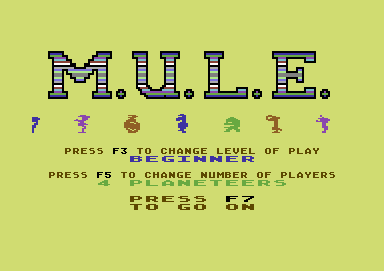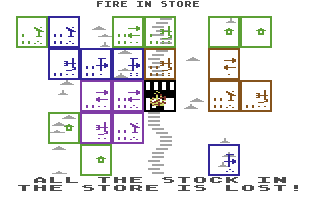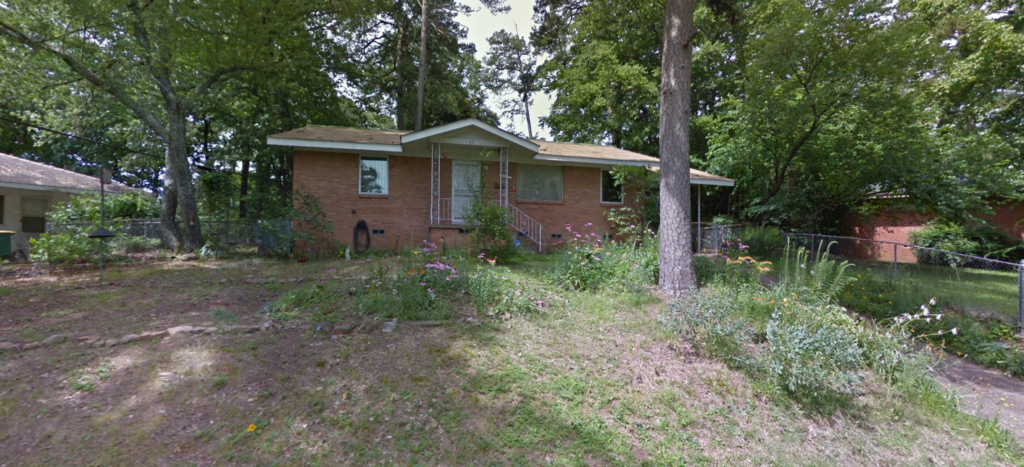
A nondescript house near Lake Broadmoor in Little Rock, Arkansas, USA, is the origin of M.U.L.E.: the headquarters of Ozark Softscape, the game company founded in 1982 by Dan Bunten, Bill Bunten, Alan Watson and Jim Rushing. Because of Dan Bunten’s previous development of Cartels & Cutthroats, Electronic Arts (EA) founder Trip Hawkins took Ozark Softscape under his wing. After about six months of development in late 1982 and early 1983, M.U.L.E. became one of EA’s first published games. It was released for the Atari 400/800 on 23 May 1983, with the C64 version following in November of the same year after another three months of development.
M.U.L.E. established the genre of “couch gaming”, the computer game as a family social event. The main inspiration for this was the family game nights of the developers’ youth. The Atari home computer, with its four joystick ports, was ideally suited to transferring this board-game flair to the computer. In 1983, the vast majority of computer games were designed for a single player experience. It was not until the 1990s that “couch gaming” became increasingly popular, with games such as Bomberman and Super Mario Kart. Nintendo, in particular, recognised the trend and in the mid-1990s added four joystick ports to another console, the N64. Sega’s Dreamcast also had the privilege, and with the help of an Atari emulator, the Dreamcast is still a good platform for playing the original M.U.L.E. today. It was only in the 2000s, with the “casual gaming” of the Nintendo Wii and, of course, the age of online gaming, that this vision became commonplace in the games industry. M.U.L.E. was far ahead of its time and truly visionary in this regard.
Although M.U.L.E. can be played on a computer alone, thanks to the AI developed by Jim Rushing, which was surprisingly good for the time, it really unfolds its magic with four human players. The dynamics of the on-screen events during the colonisation of the planet Irata always create a dynamic between the human players in front of the screen. “Please, please sell me more energy!” – “Can’t we swap these two plots of land?” – “On the left is the wampus! No, on the right! It was the vision of the designers of M.U.L.E., led by Dan Bunten, to tease out such human interactions: “On your deathbed, you don’t wish you had spent more time alone at the computer. M.U.L.E. tournaments with four human players enjoy cult status. Even 40 years after the game’s release, there are still many active private tournament rounds of this kind around the world, at cake or barbecue parties, as evidenced by the regular posts in the M.U.L.E. communities on social media.
Over the course of 40 years, games have come close to the original, but never quite matched it. Dan’s and later Dani’s own plans to revive M.U.L.E. never saw the light of day. Deluxe M.U.L.E. for the Atari ST and Amiga failed in 1987, then again in 1990. Son of M.U.L.E. for the Sega Mega Drive failed in 1993 due to differences between Dani and publisher EA. Dani’s 1997 plans for a new edition in the dawning online age, M.U.L.E.: Planet Prospector, could not be realised due to her lung cancer and her untimely death in 1998.
Dan Bunten went through a gender transition in 1992 and changed her name to Danielle. In this report we refer to her as either Dan or Dani(elle), matched with the timeframes of the individual topics/projects discussed in the report. We believe this is what Danielle would have thought to be ok, based on the accounts on the topic in Sid Meier’s memoirs, but also her own reflections on her transition archived here and here.

We can only hope that M.U.L.E. Online, due out in 2023, is not the end of the M.U.L.E. story, and that we will have more news to report in the future. The game deserves to be remembered by the first generation of players. It deserves to be passed on to future generations of players, not only in its original form, but also with worthy remakes that take into account Dani’s ideas for the game’s future.
We are now embarking on a chronological journey through the 40-year history of “The World of M.U.L.E.”. In keeping with the chronology, we let contemporary witnesses and current protagonists of the M.U.L.E. legacy speak in our interviews. We would like to thank our interviewees for their time and for kindly providing us with the visual material to support this article. Let’s start in 1983 with the original Atari and C64 versions.
May 1983 – Atari 800
Although the original version of the game is not as widespread as the C64 version, it enjoys the status of “best of all M.U.L.E. versions” among connoisseurs. This is partly due to the fact that four joysticks can be connected directly to the Atari 400/800, allowing four human players to play comfortably without having to use the keyboard. On the other hand, it is the only version that is almost free of bugs, contains some game elements that are missing in other versions, and has a slightly higher level of difficulty, which of course makes it more attractive to connoisseurs. Until a few years ago, there was a persistent rumour that the Atari version only had 128 squares that had to be memorised in order to play the game at its best. However, various reverse-engineering efforts proved this to be untrue.
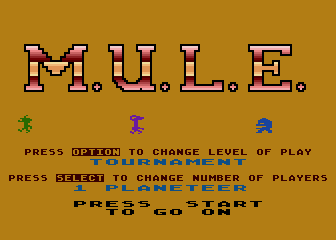
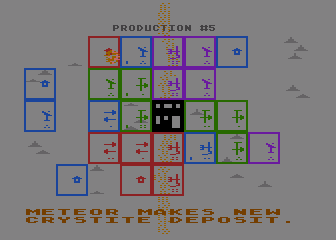
November 1983 – Commodore 64
The C64 version is the only one still being developed by Ozark Softscape. Compared to the original Atari version, some bugs have crept in. For example, the wampus on the top mountain cannot be captured, there are never mountains in the right two columns of the board, and the value of food plots is calculated incorrectly for the statistics. A clear plus point is the great SID implementation of Roy Glover’s music, which sounds much better than the Atari original despite the lack of a fourth voice. Due to the lower distribution of the Atari 400/800, the C64 version is still the most played M.U.L.E. version. Fans have developed a variant, available on CSDB, which supports the four-player joystick adapter for the user port, in order to catch up with the Atari original in this respect. However, fans are still waiting for a version that fixes the above-mentioned bugs to get it on par with the Atari version.
